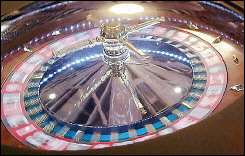Chaos theory helps to predict the outcome at the roulette table

At first glance, a roulette table looks like a jumble of numbers and a randomly hopping little white ball. But with a better understanding of physics and some general knowledge of the starting conditions, it may be possible to shift the odds of winning a little in your favor. According to new research published in the American Institute of Physics' journal Chaos, by knowing some of the starting conditions – such as the speed of the spin and the rotation of the ball – this game of chance starts to look a little less random.
Under normal conditions, according to the researchers, the anticipated return on a random roulette bet is -2.7 percent. By applying their calculations to a casino-grade roulette wheel and using a simple clicker device, the researchers were able to achieve an average return of 18 percent, well above what would be expected from a random bet.
With more complete information, such as monitoring by an overhead camera, the researchers were able to improve their accuracy even further. This highly intrusive scheme, however, could not be deployed under normal gambling conditions. The researchers also observed that even a slight tilt in the wheel would produce a very pronounced bias, which could be exploited to substantially improve the accuracy of their predictions.
This model, however, does not take into account the minor changes of the friction of the surfaces, the level of the wheel, or the manner in which the croupier plays the ball—any of which would thwart the advantage of the physicist/gambler. The gambler, the researchers conclude, can rest assured that the game is on some level predictable, and therefore inherently honest.
More information: Predicting the outcome of roulette, Chaos 22, 033150 (2012); dx.doi.org/10.1063/1.4753920
Abstract
There have been several popular reports of various groups exploiting the deterministic nature of the game of roulette for profit. Moreover, through its history, the inherent determinism in the game of roulette has attracted the attention of many luminaries of chaos theory. In this paper, we provide a short review of that history and then set out to determine to what extent that determinism can really be exploited for profit. To do this, we provide a very simple model for the motion of a roulette wheel and ball and demonstrate that knowledge of initial position, velocity, and acceleration is sufficient to predict the outcome with adequate certainty to achieve a positive expected return. We describe two physically realizable systems to obtain this knowledge both incognito and in situ. The first system relies only on a mechanical count of rotation of the ball and the wheel to measure the relevant parameters. By applying these techniques to a standard casino-grade European roulette wheel, we demonstrate an expected return of at least 18%, well above the −2.7% expected of a random bet. With a more sophisticated, albeit more intrusive, system (mounting a digital camera above the wheel), we demonstrate a range of systematic and statistically significant biases which can be exploited to provide an improved guess of the outcome. Finally, our analysis demonstrates that even a very slight slant in the roulette table leads to a very pronounced bias which could be further exploited to substantially enhance returns.
Journal information: Chaos
Provided by American Institute of Physics


















